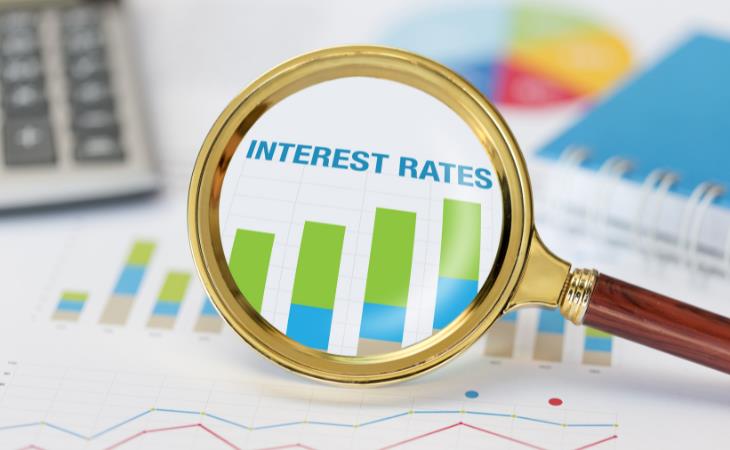Investment advisors explain that when interest rates are on the upswing, specific assets, such as bonds, gain greater allure among investors. It would be prudent for investors in such a climate to construct a portfolio comprised of high-quality bonds of moderate duration. This approach enables them to generate income and potentially counterbalance equity risk.
Bonds are structured to perform well in declining interest rate environments but can face challenges when rates rise. Investing in bonds during high-rate periods and selling them during low-rate periods can yield returns exceeding the bond's interest payments. When interest rates fall, newly issued bonds offer lower rates, while your existing bonds continue to pay higher interest, thereby increasing their value and price, and increasing your returns. There are moments when bonds outshine equities. The important factor in determining bond performance is whether interest rates will stabilize, rise, or fall.
2. Give priority to dividend-paying stocks
When interest rates are on the rise, it's important to give priority to dividend-paying stocks. Companies in sectors like consumer staples and healthcare tend to remain profitable in such circumstances. Investment professionals suggest focusing on dividend stocks that have the capacity to boost their yields. This approach proves advantageous during periods of rising interest rates, as higher rates typically translate into increased dividend yields. Investing in dividend-paying stocks becomes an attractive option due to their ability to compete with the higher interest rates offered by banks.
3. Explore investment opportunities in banks and brokerage firms
Banks and brokerage firms generate revenue through interest, and higher interest rates can boost their earnings. When rates rise, credit becomes less accessible, resulting in higher borrowing costs for consumers. In previous instances of Federal Reserve rate hikes, financial service providers, including banks and brokerages, have witnessed enhanced interest income and improved profit margins.
On the flip side, low-interest-rate environments often result in borrowers having more disposable income. This leads to greater spending and increased borrowing activity, enabling banks to earn more from the interest generated in larger quantities. Even in times of low rates, banks sustain their profitability through the collection of fees, commissions, and service charges from their clientele.
4. Tap into the potential of cash-rich companies
Cash-rich companies stand to benefit from rising interest rates, as they can maximize returns on their cash reserves. Investors should target companies with low debt-to-equity (D/E) ratios or substantial cash holdings. Established, financially sound companies known for their substantial cash reserves, like Apple (AAPL), which boasted $28.4 billion in cash reserves at the conclusion of its second fiscal quarter in 2023, present enticing investment opportunities.
Related: Retirement Planning: The 7 Biggest Mistakes People Make
5. Buy when rates are low
Those looking to make substantial acquisitions, whether in property or income-generating assets, should seize the chance to buy when long-term interest rates are at their lowest. Acting before interest rates surge can yield substantial savings in financing costs and overall expenses in the long run. To successfully execute this strategy, stay informed about the Federal Reserve's actions and economic developments to anticipate future interest rate hikes.
6. Investing strategically in technology and healthcare
While many investors opt for dividend stocks, those looking for sustained growth in the context of interest rates should explore different avenues. Companies in the mature tech and healthcare sectors tend to reinvest profits for future growth, rather than distributing them as dividends.
7. Consider short-term or floating-rate bonds
In times of uncertainty, like rising interest rates and looming inflation, diversifying your portfolio is key. This entails exploring new income sources, particularly for bond investors. One strategy to stabilize your portfolio's performance is to transition to short-term maturity bonds or invest in bonds with floating coupon rates that align with market fluctuations.
Keep in mind that diversifying your investments is essential. A multi-asset strategy can mitigate market risks and enhance your investment returns.
8. Fine-tune your tax efficiency
To minimize tax liabilities, financial experts advise fine-tuning your investment approach by reducing exposure to tax-inefficient assets in tax-advantaged accounts and increasing allocations to tax-efficient assets in taxable accounts. Furthermore, in the face of market volatility causing depreciation in certain investments you intend to divest, exploring loss "harvesting" within your taxable accounts this year may help counterbalance taxable capital gains generated by high-performing investments.
Financial advisors stress that, while you consider these steps, it's important to understand that short-term buying and selling in an attempt to predict market swings is not advisable. Numerous studies have confirmed that efforts to time the markets often result in failure, and missing just a few of the best market days can have significant repercussions on your overall returns. The best course of action is to remain invested in a diversified portfolio spanning different asset classes. Additionally, ensure that any changes you implement align with your long-term objectives. Consult with your advisor to determine which steps are appropriate for your specific financial situation.
9. Buy or invest in real estate
Real estate tends to appreciate, sometimes even outpacing interest rate increases. Opting to buy real estate or invest in real estate investment trusts (REITs) offers a profitable avenue to leverage rising interest rates. Although higher rates may pose challenges for borrowers, savvy investors can thrive by making informed choices.
Take advantage of the reduced demand for home purchases and seize the opportunity to acquire rental properties at lower prices. Renting out these properties to tenants at higher rates can lead to increased rental income and the potential for property value appreciation. To safeguard your investment against rising interest rates, it's essential to explore fixed-rate loans, which will help keep your mortgage payments stable.






